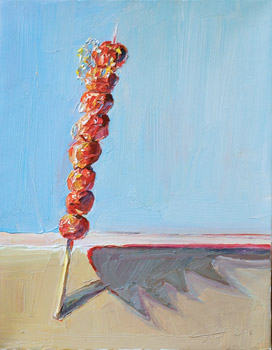
Jian Wang is a painter in the Bay Area figurative tradition, having studied under such masters as Wayne Thiebaud, Manuel Neri, and Roland Petersen. Wang grew up in China, and he moved to the US at age 28. His journey is remarkable, but looking back, it seems like fate. Born in Dalian in 1958, Wang showed artistic talent at a young age and worked diligently to develop it--he is a self-proclaimed workaholic. He studied Russian Social Realism in school, and self-studied his real passion: masters such as Michelangelo and Rembrandt. But access to European artists was limited. \"I studied books that had really bad representations,\" says Wang.
At age twelve Wang was accepted into the Dalian Youth Palace of Arts, where he studied for six years. At the urging of his parents he earned his degree in engineering, a discipline he then taught for four years. At every opportunity, however, he created artwork. One of the other instructors, Marjorie Francisco, a retired school teacher from California, noticed his talent. It was at Francisco\'s urging that Wang made the decision
to move to Sacramento, to embrace a life as an artist. \"I had this dream to be an artist since childhood,\" says Wang. \"There is a romance of it. And I didn\'t know the reality of being a starving artist.\" Wang attributes part of the appeal of his work to its naive honesty. \"It is innocent and direct,\" he explains. \"It\'s not pretentious. I think people respond to that.\"
Wang began his studies at Sacramento City College under Fred Dalky before transferring to UC Davis to work with Thiebaud and others, and then California State University, Sacramento, to earn his Master\'s. One of Thiebaud\'s first observations was that Wang\'s paintings weren\'t alive and suffered from a dull, dark palette. It was a holdover habit from his days copying poor reproductions. Thiebaud handed Wang a book of work by Wolf Kahn to study. \"I didn\'t just look at it,\" says Wang. \"I copied every single painting. I freed myself from brownish black. My specific drive is for my work to reflect living.\"
Like the instructors who influenced him, Wang creates still-lifes, landscapes, and figurative work; his subjects include the American River, Chinese candies, and portraits of Asian women. While his painting resembles that of Thiebaud and others who paint in the genre, his technique has morphed into one that is his own. Instead of a palette, Wang uses a box into which he deposits seven or eight colors of paint. He then thickly applies and mixes it, in quick strokes, directly on the canvas. Wang\'s process is called premiere coup painting--rapidly painting what\'s directly in front of you. \"Thiebaud says that I am always on the edge of success or failure,\" Wang notes. \"It is a risk.\" For Wang, this brings rhythm and life to his work. \"It\'s a musical rhythm,\" he says. \"Like running water--a flow.\"
In 2008, Wang was given a solo show at the National Art Museum of China, in conjunction with the Beijing Olympics. \"It\'s unusual to have a Chinese artist who is Western trained,\" he explains of the Chinese government\'s interest in his work. \"They wanted to show how a Chinese person could have a masterful ability to make oil paintings.\" He became nationally recognized almost instantly; Wang\'s next solo exhibition in China will take place next year at the Dongguan Art Museum. Despite his unconventional path, Wang\'s passion, and drive, remain as strong as ever. \"I used to joke that I wanted to live to one hundred years old,\" he says. \"Now I only hope that so I have the time to make a great painting.\"
This article was written for and published in art ltd. magazine 
